Microclimate Drives Shelter-Seeking Behaviour in Lambing Ewes
Abstract
:1. Introduction
2. Materials and Methods
2.1. Study Site
2.2. Climate and Microclimate Parameters
2.3. Animals and GPS Collars
2.4. Spatial Parameters
2.5. Modelling of the Wind Field
2.6. Statistical Analysis
2.6.1. Preference Index
2.6.2. Spatial Autocorrelation Moran’s I
2.6.3. Hotspot (Getis-Ord Gi*) Analysis
2.6.4. Parameters Applied in Moran’s I and Hotspot Analysis
2.6.5. Spatial Correlation of Slope and Hotspot Analysis
2.7. Agent-Based Model
3. Results
3.1. Ewe Area Preference Index (PI)
3.2. Hotspot Analysis (Getis-Ord Gi*)

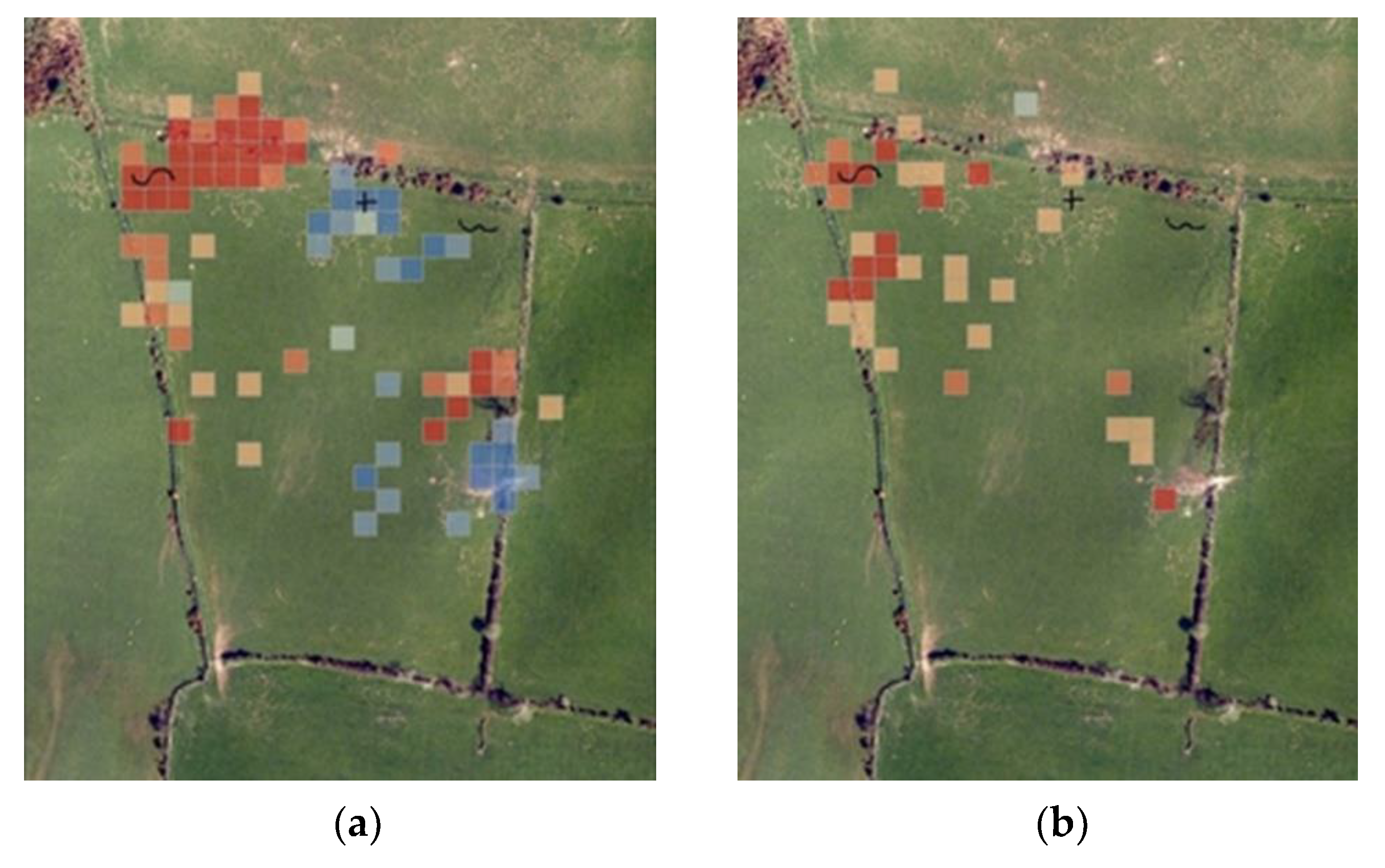
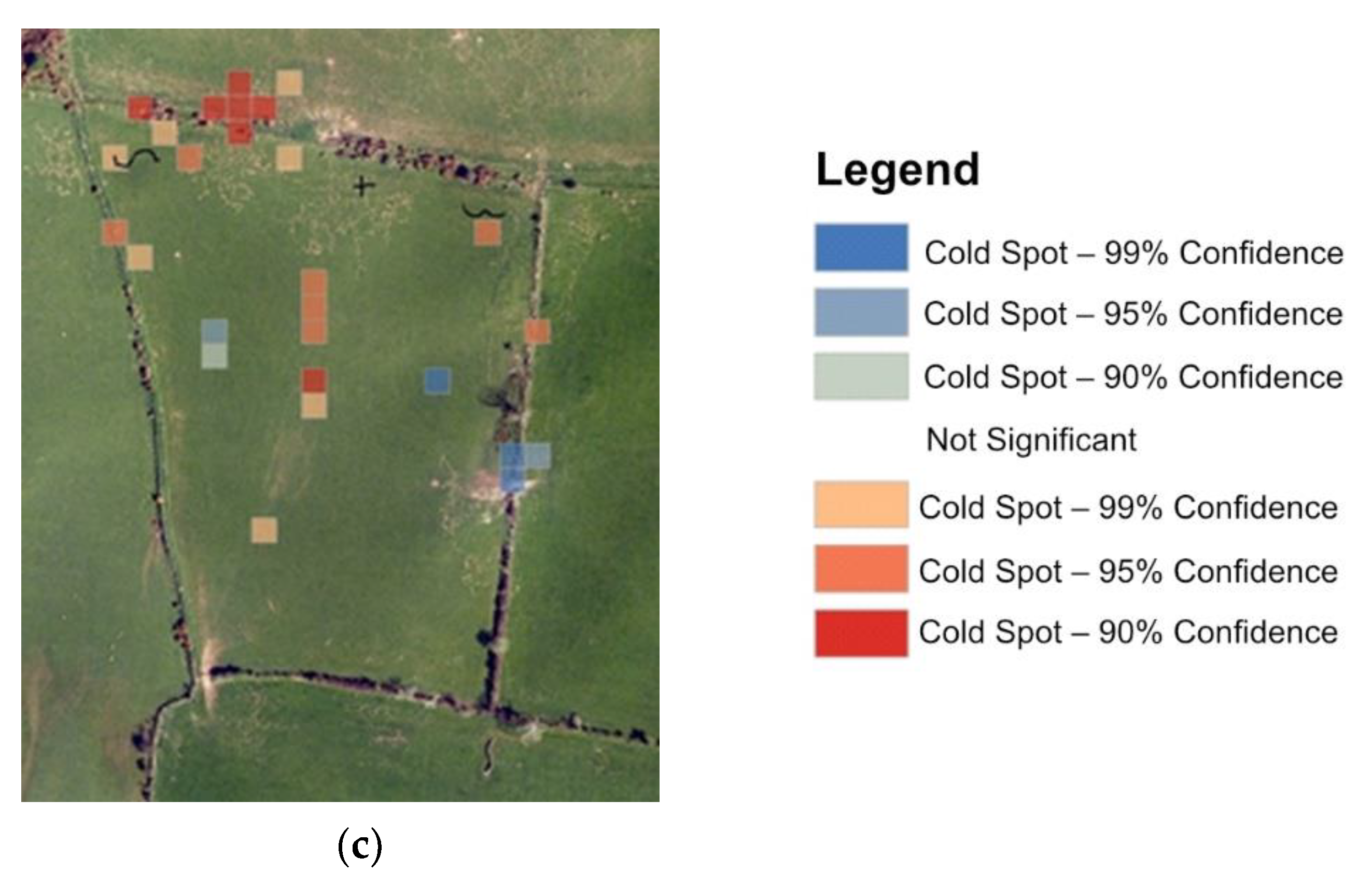
3.3. Spatial Autocorrelation (Moran’s I)
3.4. Wind Field Model
3.5. Agent-Based Model
4. Discussion
5. Conclusions
Supplementary Materials
Author Contributions
Funding
Data Availability Statement
Acknowledgments
Conflicts of Interest
References
- Sinclair, F.L. A general classification of agroforestry practice. Agrofor. Syst. 1999, 46, 161–180. [Google Scholar] [CrossRef]
- Lynch, J.J.; Mottershead, B.E.; Alexander, G. Sheltering behaviour and lamb mortality amongst shorn Merino ewes lambing in paddocks with a restricted area of shelter or no shelter. Appl. Anim. Ethol. 1980, 6, 163–174. [Google Scholar] [CrossRef]
- Pritchard, C.E.; Williams, A.P.; Davies, P.; Jones, D.; Smith, A.R. Spatial behaviour of sheep during the neonatal period: Preliminary study on the influence of shelter. Animal 2021, 15, 100252. [Google Scholar] [CrossRef] [PubMed]
- Varah, A.; Jones, H.; Smith, J.; Potts, S.G. Enhanced biodiversity and pollination in UK agroforestry systems. J. Sci. Food Agric. 2013, 93, 2073–2075. [Google Scholar] [CrossRef] [PubMed]
- Prevedello, J.A.; Almeida-Gomes, M.; Lindenmayer, D.B. The importance of scattered trees for biodiversity conservation: A global meta-analysis. J. Appl. Ecol. 2018, 55, 205–214. [Google Scholar] [CrossRef]
- Mellor, D.J.; Stafford, K.J. Animal welfare implications of neonatal mortality and morbidity in farm animals. Vet. J. 2004, 168, 118–133. [Google Scholar] [CrossRef] [PubMed]
- Bowen, J.P.; Martin, J. The ‘Big Freeze’ of 1962–1963: The loss of livestock, the issue of fodder supply and the problem of the commons in two upland hill-farming regions in England and Wales. Agric. Hist. Rev. 2016, 64, 226–260. [Google Scholar]
- Jordon, M.W.; Willis, K.J.; Harvey, W.J.; Petrokofsky, L.; Petrokofsky, G. Implications of Temperate Agroforestry on Sheep and Cattle Productivity, Environmental Impacts and Enterprise Economics. A Systematic Evidence Map. Forests 2020, 11, 1321. [Google Scholar] [CrossRef]
- Bianca, W. The signifiance of meteorology in animal production. Int. J. Biometeorol. 1976, 20, 139–156. [Google Scholar] [CrossRef]
- Mount, L.E.; Brown, D. The use of meteorological records in estimating the effects of weather on sensible heat loss from sheep. Agric. Meteorol. 1982, 27, 241–255. [Google Scholar] [CrossRef]
- McArthur, A.J.; Ousey, J.C. Heat-loss from a wet animal–Changes with time in the heat-balance of a physical model representing a newborn homeotherm. J. Therm. Biol. 1994, 19, 81–89. [Google Scholar] [CrossRef]
- McArthur, A.J.; Monteith, J.L. Air movement and heat-loss from sheep.2. Thermal insulation of fleece in wind. Proc. R. Soc. Ser. B-Biol. Sci. 1980, 209, 209–217. [Google Scholar] [CrossRef]
- Dwyer, C.M. The welfare of the neonatal lamb. Small Rumin. Res. 2008, 76, 31–41. [Google Scholar] [CrossRef]
- Munro, J. The use of natural shelter by hill sheep. Anim. Sci. 1962, 4, 343–349. [Google Scholar] [CrossRef]
- Gregory, N.G. The role of shelterbelts in protecting livestock: A review. N. Z. J. Agric. Res. 1995, 38, 423–450. [Google Scholar] [CrossRef]
- Baker, T.P.; Moroni, M.T.; Hunt, M.A.; Worledge, D.; Mendham, D.S. Temporal, environmental and spatial changes in the effect of windbreaks on pasture microclimate. Agric. For. Meteorol. 2021, 297, 1–10. [Google Scholar] [CrossRef]
- Bird, P.R.; Jackson, T.T.; Kearney, G.A.; Roache, A. Effects of windbreak structure on shelter characteristics. Aust. J. Exp. Agric. 2007, 47, 727–737. [Google Scholar] [CrossRef]
- Taylor, D.B.; Schneider, D.A.; Brown, W.Y.; Price, I.R.; Trotter, M.G.; Lamb, D.W.; Hinch, G.N. GPS observation of shelter utilisation by Merino ewes. Anim. Prod. Sci. 2011, 51, 724–737. [Google Scholar] [CrossRef]
- Pollard, J.C. Shelter for lambing sheep in New Zealand: A review. N. Z. J. Agric. Res. 2006, 49, 395–404. [Google Scholar] [CrossRef] [Green Version]
- Donnelly, J.B.; Lynch, J.J.; Webster, M.E.D. Climatic adaptation in recently shorn merino sheep. Int. J. Biometeorol. 1974, 18, 233–247. [Google Scholar] [CrossRef]
- Mcarthur, A.J.; Monteith, J.L. Air movement and heat loss from sheep. I. Boundary layer insulation of a model sheep, with and whoitut fleece. Proc. R. Soc. London. Ser. B Biol. Sci. 1980, 209, 187–208. [Google Scholar] [CrossRef]
- Pollard, J.C.; Littlejohn, R.P. Shelter for lambing in southern New Zealand. II. Sheltering behaviour and effects on productivity. N. Z. J. Agric. Res. 1999, 42, 171–177. [Google Scholar] [CrossRef] [Green Version]
- Aycrigg, J.L.; Wells, A.G.; Garton, E.O.; Magipane, B.; Liston, G.E.; Prugh, L.R.; Rachlow, J.L. Habitat selection by Dall’s sheep is influenced by multiple factors including direct and indirect climate effects. PLoS ONE 2021, 16, e0248763. [Google Scholar] [CrossRef] [PubMed]
- Fogarty, E.S.; Swain, D.L.; Cronin, G.; Trotter, M. Autonomous on-animal sensors in sheep research: A systematic review. Comput. Electron. Agric. 2018, 150, 245–256. [Google Scholar] [CrossRef]
- Baker, T.P.; Moroni, M.T.; Mendham, D.S.; Smith, R.; Hunt, M.A. Impacts of windbreak shelter on crop and livestock production. Crop Pasture Sci. 2018, 69, 785. [Google Scholar] [CrossRef]
- Carslaw, D.C.; Ropkins, K. openair–An R package for air quality data analysis. Environ. Model. Softw. 2012, 27–28, 52–61. [Google Scholar] [CrossRef]
- Ltd, I. Innovis Breeding Sheep. Available online: https://www.innovis.org.uk/breeding-sheep/ (accessed on 22 November 2022).
- Russel, A. Body condition scoring of sheep. Pract. 1984, 6, 91–93. [Google Scholar] [CrossRef]
- He, Y.F.; Jones, P.J.; Rayment, M. A simple parameterisation of windbreak effects on wind speed reduction and resulting thermal benefits to sheep. Agric. For. Meteorol. 2017, 239, 96–107. [Google Scholar] [CrossRef] [Green Version]
- Wales, N.R. LiDAR Composite Dataset. Available online: https://lle.gov.wales/catalogue/item/LidarCompositeDataset/?lang=en (accessed on 16 November 2021).
- Maclean, I.M.D.; Mosedale, J.R.; Bennie, J.J. Microclima: An r package for modelling meso- and microclimate. Methods Ecol. Evol. 2019, 10, 280–290. [Google Scholar] [CrossRef] [Green Version]
- Maps, G. Innovis field site. Available online: https://www.arcgis.com/apps/fieldmaps/ (accessed on 18 November 2021).
- Pebesma, E.J. Multivariable geostatistics in S: The gstat package. Comput. Geosci. 2004, 30, 683–691. [Google Scholar] [CrossRef]
- Graler, B.; Pebesma, E.; Heuvelink, G. Spatio-Temporal Interpolation using gstat. R J. 2016, 8, 204–218. [Google Scholar] [CrossRef]
- Wickham, H.; Averick, M.; Bryan, J.; Chang, W.; Mcgowan, L.; François, R.; Grolemund, G.; Hayes, A.; Henry, L.; Hester, J.; et al. Welcome to the Tidyverse. J. Open Source Softw. 2019, 4, 1686. [Google Scholar] [CrossRef] [Green Version]
- Wickham, H. Ggplot2: Elegant Graphics for Data Analysis; Springer: New York, NY, USA, 2016. [Google Scholar]
- Broster, J.C.; Dehaan, R.L.; Swain, D.L.; Robertson, S.M.; King, B.J.; Friend, M.A. Shelter type and birth number influence the birth and death sites of lambs and ewe movement around lambing time. J. Anim. Sci. 2017, 95, 81–90. [Google Scholar] [CrossRef] [PubMed]
- ESRI. How Spatial Autocorrelation Analysis Works. Available online: https://pro.arcgis.com/en/pro-app/latest/tool-reference/spatial-statistics/h-how-spatial-autocorrelation-moran-s-i-spatial-st.htm (accessed on 12 November 2021).
- Getis, A.; Ord, J.K. The analysis of spatial association by use of distance statistics. Geogr. Anal. 1992, 24, 189–206. [Google Scholar] [CrossRef]
- Wilensky, U.; Reisman, K. Thinking Like a Wolf, a Sheep, or a Firefly: Learning Biology Through Constructing and Testing Computational Theories—An Embodied Modeling Approach. Cogn. Instr. 2006, 24, 171–209. [Google Scholar] [CrossRef]
- Wilensky, U. NetLogo Flocking Model. 1998. Available online: https://ccl.northwestern.edu/netlogo/models/Flocking (accessed on 21 November 2021).
- Winfield, C.J.; Brown, W.; Lucas, I.A.M. Sheltering behaviour at lambing by Welsh Mountain ewes. Anim. Sci. 1969, 11, 101–105. [Google Scholar] [CrossRef]
- Ngo, T.T.; Letchford, C.W. Experimental study of topographic effects on gust wind speed. J. Wind. Eng. Ind. Aerodyn. 2009, 97, 426–438. [Google Scholar] [CrossRef]
- Xiong, H.; Pandey, G.; Steinbach, M.; Kumar, V. Enhancing data analysis with noise removal. IEEE Trans. Knowl. Data Eng. 2006, 18, 304–319. [Google Scholar] [CrossRef]
- Ramseyer, A.; Boissy, A.; Thierry, B.; Dumont, B. Individual and social determinants of spontaneous group movements in cattle and sheep. Animal 2009, 3, 1319–1326. [Google Scholar] [CrossRef]
- Champion, R.A.; Rutter, S.M.; Penning, P.D.; Rook, A.J. Temporal variation in grazing behavior of sheep and the reliability of sampling periods. Appl. Anim. Behav. Sci. 1994, 42, 99–108. [Google Scholar] [CrossRef]
- Sibbald, A.M.; Oom, S.P.; Hooper, R.J.; Anderson, R.M. Effects of social behaviour on the spatial distribution of sheep grazing a complex vegetation mosaic. Appl. Anim. Behav. Sci. 2008, 115, 149–159. [Google Scholar] [CrossRef]
- Dumont, B.; Boissy, A. Grazing behaviour of sheep in a situation of conflict between feeding and social motivations. Behav. Process. 2000, 49, 131–138. [Google Scholar] [CrossRef] [PubMed]
- Beausoleil, N.J.; Stafford, K.J.; Mellor, D.J. Sheep show more aversion to a dog than to a human in an arena test. Appl. Anim. Behav. Sci. 2005, 91, 219–232. [Google Scholar] [CrossRef]
- Festabianchet, M. Seasonal range selection in bighorn sheep–Conflicts between forage quality, forage quantity, and predator avoidance. Oecologia 1988, 75, 580–586. [Google Scholar] [CrossRef] [PubMed]
- Hutson, G.D.; Vanmourik, S.C. Effect of artificial wind on sheep movement along indoor races. Aust. J. Exp. Agric. 1982, 22, 163–167. [Google Scholar] [CrossRef]
- Silva, S.R.; Sacarrão-Birrento, L.; Almeida, M.; Ribeiro, D.M.; Guedes, C.; González Montaña, J.R.; Pereira, A.F.; Zaralis, K.; Geraldo, A.; Tzamaloukas, O.; et al. Extensive Sheep and Goat Production: The Role of Novel Technologies towards Sustainability and Animal Welfare. Animals 2022, 12, 885. [Google Scholar] [CrossRef] [PubMed]
- Kumar, B.; Nair, P. Carbon Sequestration Potential of Agroforestry Systems: Oppoortunities and Challenges; Springer: Dordrecht, The Netherlands, 2011; Volume 8. [Google Scholar]
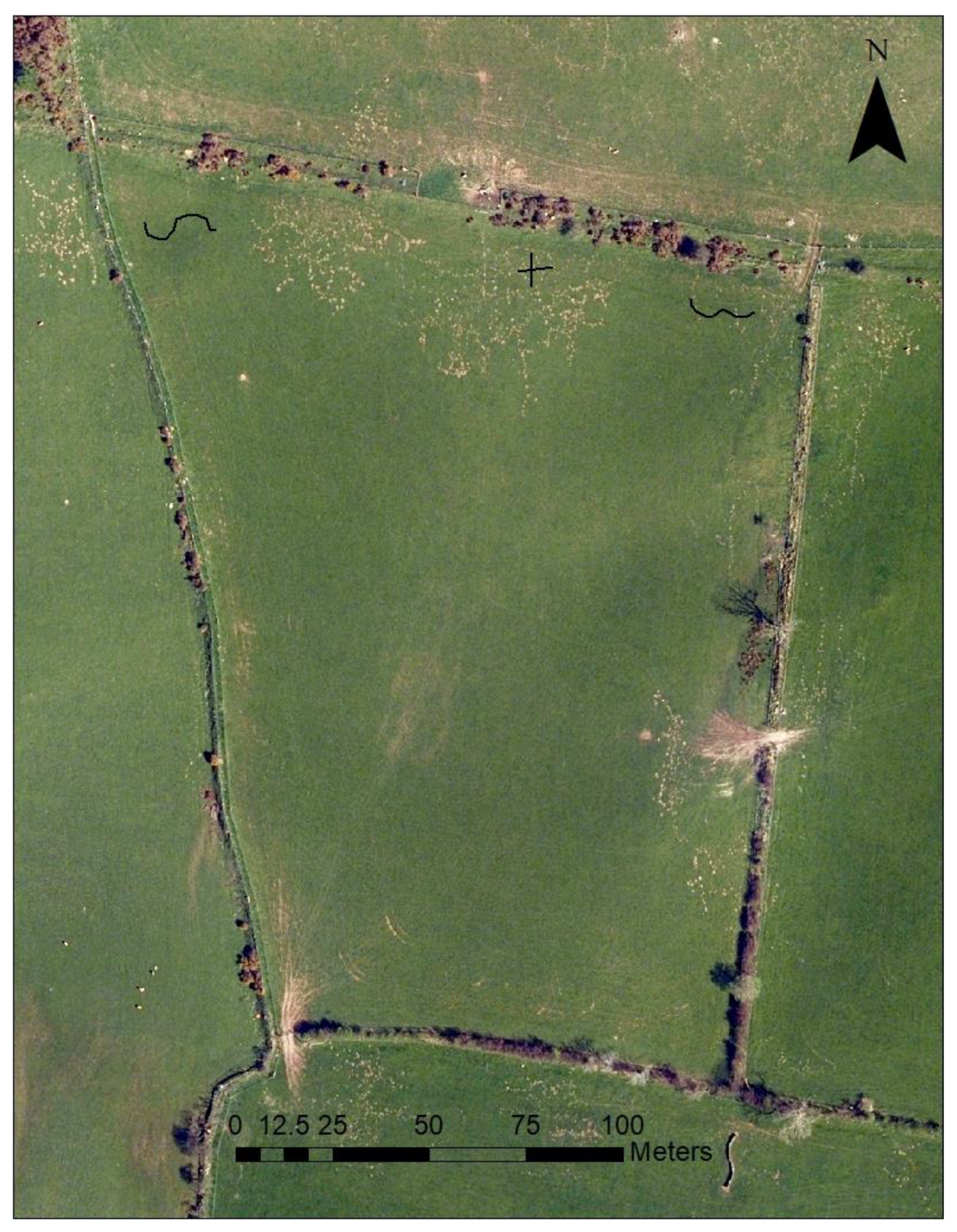
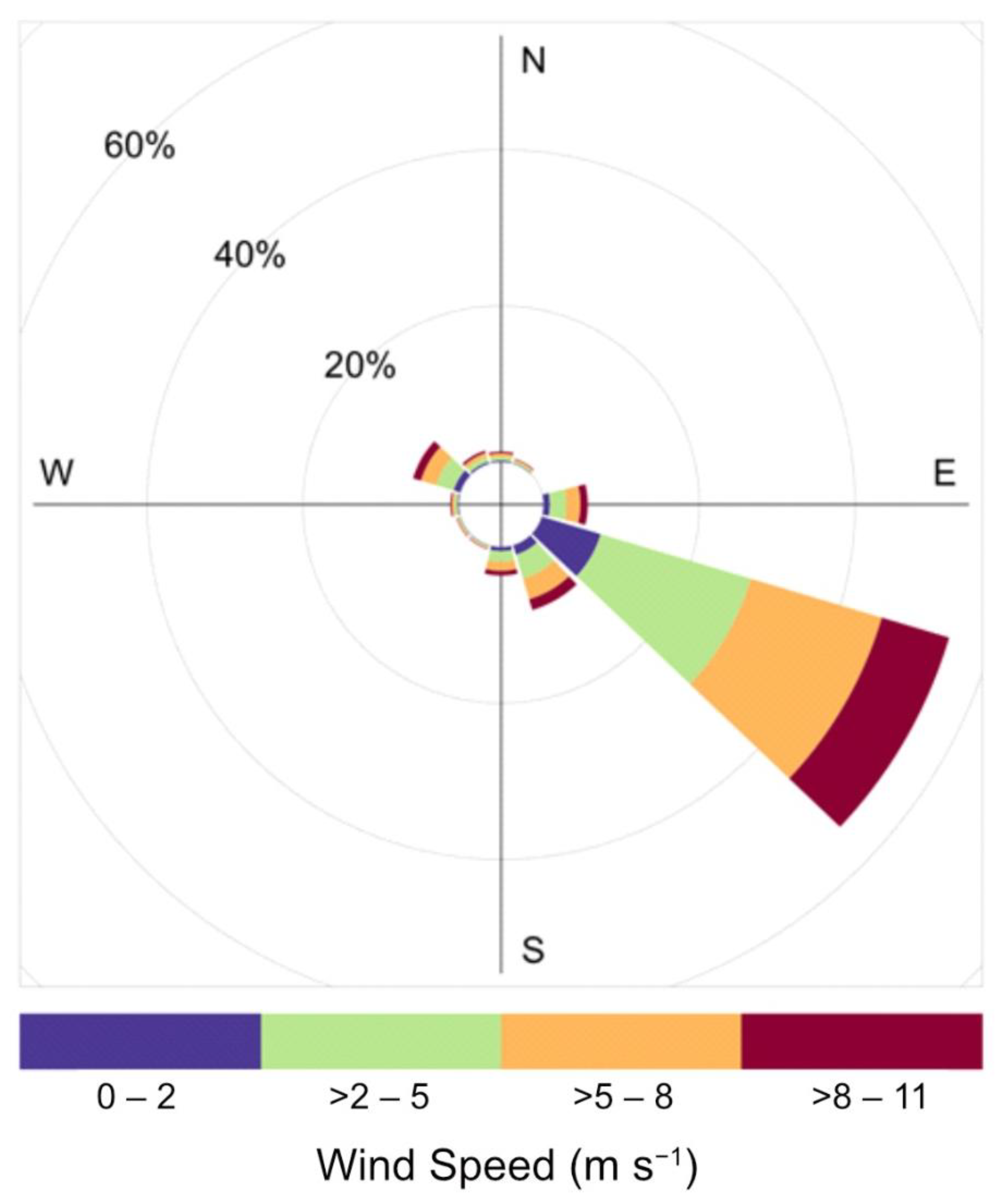

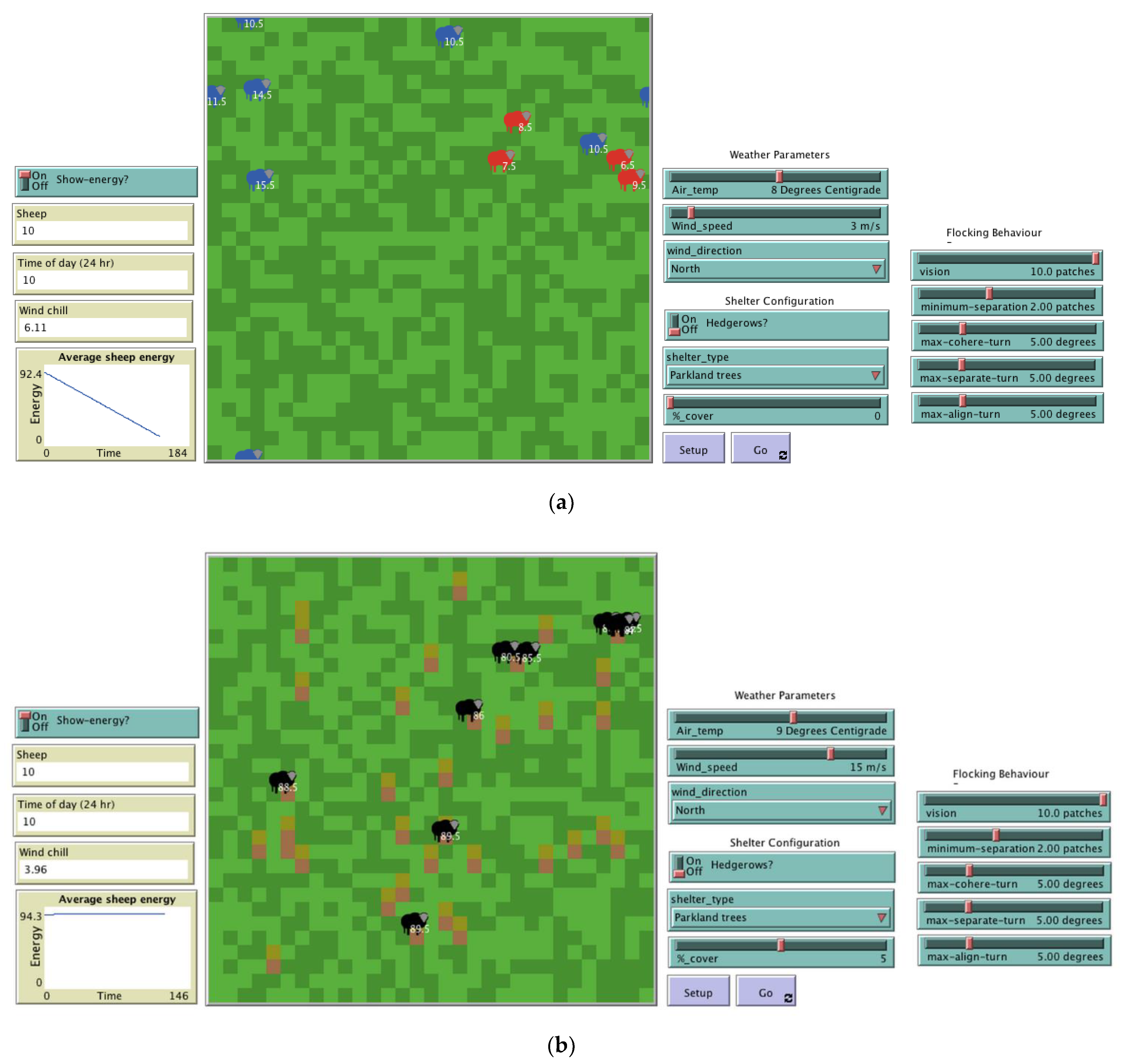
| Name | Shape | Height (m) | Length (m) | Breadth (m) | Optical Porosity (%) |
|---|---|---|---|---|---|
| Shelter 1 | Elongated S | 0.7 | 16.5 | 5.5 | 0.05 |
| Shelter 2 | Cross | 0.7 | 8.0 | 7.5 | 0.05 |
| Shelter 3 | Elongated S | 0.7 | 26.5 | 8.5 | 0.05 |
| Weather Variable | |||||||
|---|---|---|---|---|---|---|---|
| Temperature (°C) | Wind-Speed (m s−1) | Rain (mm) | Wind-Chill (°C) | ||||
| Mean | 6.18 ± 0.11 | Mean | 3.73 ± 0.09 | Total | 27.4 | Mean | 3.69 ± 0.14 |
| Minimum | 0.6 | Minimum | 0 | Daily Average | 1.96 ± 0.05 | Minimum | −5.3 |
| Maximum | 13.1 | Maximum | 9.8 | Maximum | 13.1 | ||
| Distance | Preference Utilisation Areas | ||||
|---|---|---|---|---|---|
| Shelter 1 (S) | Shelter 2 (+) | Shelter 3 (W) | Natural Shelter | Exposed Area | |
| 2.5 H | 5.63 a (±1.48) | 2.17 ab (±0.95) | 2.34 ab (±0.85) | 5.11 ab (±1.18) | 1.46 b (±0.07) |
| 5 H | 4.36 acde (±0.82) | 1.01 abcdef (±0.95) | 0.56 bcdef (±0.19) | 4.94 abcef (±1.05) | 1.46 abdf (±0.55) |
| Hotspot Analysis Output | Weather Variable | |||||||
|---|---|---|---|---|---|---|---|---|
| Figure Colour | Hot/Coldspot | Confidence Interval | Wind Speed | Wind-Chill | Temperature | |||
| Z Score Range | Z Score Range | Z Score Range | ||||||
| Lower | Upper | Lower | Upper | Lower | Upper | |||
| Cold | 99% Confidence | −3.25 | −8.88 | −3.38 | −7.52 | −3.34 | −6.31 | |
| Cold | 95% Confidence | −2.45 | −2.87 | −2.58 | −3.15 | −2.65 | −3.01 | |
| Cold | 90% Confidence | −2.15 | −2.39 | −2.28 | −2.47 | −2.30 | −2.43 | |
| Hot | 90% Confidence | 2.12 | 2.49 | 2.16 | 2.49 | 2.28 | 2.60 | |
| Hot | 95% Confidence | 2.5 | 3.14 | 2.53 | 3.13 | 2.64 | 3.29 | |
| Hot | 99% Confidence | 3.15 | 8.15 | 3.15 | 5.37 | 3.33 | 4.91 | |
| Hotspot Analysis Output | Weather Variable and Time of Day | |||||||
|---|---|---|---|---|---|---|---|---|
| Figure Colour | Hot/Coldspot | Confidence Interval | Wind Speed | Wind Speed | Wind Speed | |||
| 00:00–08:00 | 08:00–16:00 | 16:00–00:00 | ||||||
| Z Score Range | Z Score Range | Z Score Range | ||||||
| Lower | Upper | Lower | Upper | Lower | Upper | |||
| Hot | 99% Confidence | 2.95 | 7.75 | 3.48 | 5.20 | 3.29 | 5.39 | |
| Hot | 95% Confidence | 2.35 | 2.93 | 2.92 | 3.02 | 2.75 | 2.97 | |
| Hot | 90% Confidence | 1.99 | 2.24 | 2.48 | 2.88 | 2.42 | 2.61 | |
| Cold | 90% Confidence | −2.05 | −2.21 | −2.89 | ~ | −2.48 | ~ | |
| Cold | 95% Confidence | −2.34 | −2.94 | ~ | ~ | −3.00 | −3.18 | |
| Cold | 99% Confidence | −2.96 | −4.38 | ~ | ~ | −3.66 | −4.99 | |
| Spatial Scale | Time Period | Weather Variable | Moran’s Index | Expected Index | Variance | z-Score | p Value |
|---|---|---|---|---|---|---|---|
| Wind speed (m s−1) | |||||||
| Field | 00:00–24:00 | 3.73 ± 0.09 | 0.08 | −0.000086 | 0.000002 | 58.61 | <0.01 |
| 00:00–08:00 | 3.91 ± 0.19 | 0.21 | −0.000237 | 0.000013 | 57.06 | <0.01 | |
| 08:00–16:00 | 4.49 ± 0.20 | 0.08 | −0.000250 | 0.000016 | 20.47 | <0.01 | |
| 16:00–00:00 | 2.91 ± 0.17 | 0.09 | −0.000023 | 0.000023 | 18.53 | <0.01 | |
| Local | 00:00–24:00 | n/a | 0.17 | −0.000086 | 0.000002 | 121.96 | <0.01 |
| Wind-chill (°C) | |||||||
| Field | 00:00–24:00 | 3.69 ± 0.14 | 0.11 | −0.000086 | 0.000004 | 51.79 | <0.01 |
| 00:00–08:00 | 1.65 ± 0.27 | 0.08 | −0.000237 | 0.000013 | 21.85 | <0.01 | |
| 08:00–16:00 | 4.31 ± 0.32 | 0.15 | −0.000250 | 0.000016 | 37.79 | <0.01 | |
| 16:00–00:00 | 5.14 ± 0.30 | 0.11 | −0.000023 | 0.000023 | 22.88 | <0.01 | |
| Temperature (°C) | |||||||
| Field | 00:00–24:00 | 6.18 ± 0.11 | 0.05 | −0.000086 | 0.000002 | 58.91 | <0.01 |
| 00:00–08:00 | 4.49 ± 0.20 | 0.10 | −0.000237 | 0.000013 | 27.5 | <0.01 | |
| 08:00–16:00 | 7.13 ± 0.23 | 0.16 | −0.000250 | 0.000016 | 40.91 | <0.01 | |
| 16:00–00:00 | 6.99 ± 0.26 | 0.14 | −0.000023 | 0.000023 | 30.03 | <0.01 |
| Explanatory Variable | Test Statistic | Correlation Coefficient (r) | 95% CI | d.f. | p Value |
|---|---|---|---|---|---|
| Wind speed | 55.913 | 0.2139 | 0.2065–0.2212 | 65,180 | p < 0.01 |
| Slope | 13.793 | 0.0539 | 0.0462–0.0615 | 65,180 | p < 0.01 |
Publisher’s Note: MDPI stays neutral with regard to jurisdictional claims in published maps and institutional affiliations. |
© 2022 by the authors. Licensee MDPI, Basel, Switzerland. This article is an open access article distributed under the terms and conditions of the Creative Commons Attribution (CC BY) license (https://creativecommons.org/licenses/by/4.0/).
Share and Cite
Atkin-Willoughby, J.; Hollick, S.; Pritchard, C.E.; Williams, A.P.; Davies, P.L.; Jones, D.; Smith, A.R. Microclimate Drives Shelter-Seeking Behaviour in Lambing Ewes. Forests 2022, 13, 2133. https://doi.org/10.3390/f13122133
Atkin-Willoughby J, Hollick S, Pritchard CE, Williams AP, Davies PL, Jones D, Smith AR. Microclimate Drives Shelter-Seeking Behaviour in Lambing Ewes. Forests. 2022; 13(12):2133. https://doi.org/10.3390/f13122133
Chicago/Turabian StyleAtkin-Willoughby, Jack, Sam Hollick, Charlotte E. Pritchard, A. Prysor Williams, Peers L. Davies, Dewi Jones, and Andrew R. Smith. 2022. "Microclimate Drives Shelter-Seeking Behaviour in Lambing Ewes" Forests 13, no. 12: 2133. https://doi.org/10.3390/f13122133







